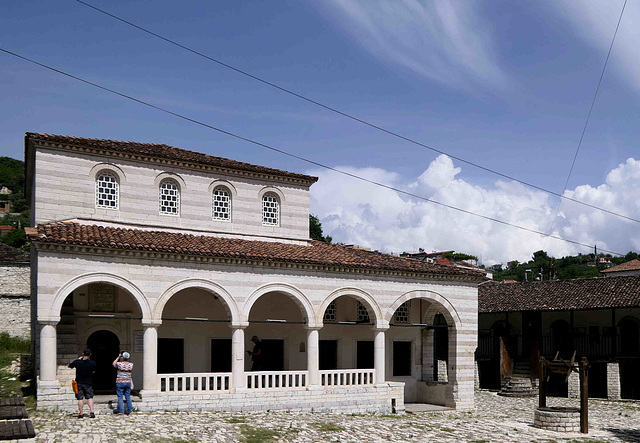Location
Lat, Lng: 40.706038, 19.952375
You can copy the above to your favourite mapping app.
Address: TEQJA E HELVETIVE
You can copy the above to your favourite mapping app.
Address: TEQJA E HELVETIVE
Keywords
Authorizations, license
-
Visible by: Everyone -
All rights reserved
-
36 visits
Berat - Halveti Tekke


Berat was known under the ancient name of Antipatrea since at least the 4th century BC. The city eventually was conquered by Macedonian king Philip V until Roman intervention. It was described as the largest settlement with significant walls but got destroyed in 200 BCE and then included within Epirus Nova, in the province of Macedonia. Following the fall of the western Roman Empire the town became part of the unstable frontier of the Byzantine Empire, when it as well suffered by Slavic invasions..
It became part of the First Bulgarian Empire in the 9th century, in 1018 surrendered to the emperor Basil II, and remained in Byzantine hands until the Second Bulgarian Empire retook the city in 1203.
In 1272 Byzantine Emperor Michael VIII asked the Albanian leaders of Berat and Durrës to abandon their alliance with Charles I of Naples, leader of the Kingdom of Albania, who had captured and incorporated it in the Kingdom of Albania. However, they contacted Charles about it as a sign of their loyalty. In 1274 Michael VIII recaptured Berat. In 1280-1281 the Sicilian forces laid siege to Berat. In March 1281 a relief force from Constantinople was able to drive off the Sicilian army and Berat again fell under the control of the Byzantine Empire.
Berat the fell into decline. By the end of the 16th century it had only 710 houses. However, it began to recover by the 17th century, and became a major craft centre. During the first part of the 16th century, Berat was a Christian city and did not contain any Muslim households. Following their expulsion from Spain, a Jewish community existed in Berat that consisted of 25 families between 1519 and 1520. End of the 16th century, Berat contained 461 Muslim houses. Conversion to Islam of the urban population in Berat had increased.
During WWII, Jews were concealed in the homes and basements of 60 families from the Muslim and Christian communities in Berat. Muslims let Jewish people worship in the local mosque.
In the 1950s, during the Communist era, Berat became a place of internal exile for those who were deemed public enemies. In 1967, Albanian author Ismail Kadare was sent to Berat, where he spent two years.
Berat, was designated a UNESCO World Heritage Site in 2008. It comprises a unique style of architecture with influences from several civilizations that have managed to coexist for centuries throughout the history.
A tekke is a building designed for meetings of a Sufi brotherhood, and the "Halveti Tekke" was a lodge dedicated to the mystical Sufi order of the Halveti.
Built in 1785 it is the successor to a tekke founded in the 15th century. The tekke is grouped around a courtyard together with a caravanserai and the King Mosque opposite.
It became part of the First Bulgarian Empire in the 9th century, in 1018 surrendered to the emperor Basil II, and remained in Byzantine hands until the Second Bulgarian Empire retook the city in 1203.
In 1272 Byzantine Emperor Michael VIII asked the Albanian leaders of Berat and Durrës to abandon their alliance with Charles I of Naples, leader of the Kingdom of Albania, who had captured and incorporated it in the Kingdom of Albania. However, they contacted Charles about it as a sign of their loyalty. In 1274 Michael VIII recaptured Berat. In 1280-1281 the Sicilian forces laid siege to Berat. In March 1281 a relief force from Constantinople was able to drive off the Sicilian army and Berat again fell under the control of the Byzantine Empire.
Berat the fell into decline. By the end of the 16th century it had only 710 houses. However, it began to recover by the 17th century, and became a major craft centre. During the first part of the 16th century, Berat was a Christian city and did not contain any Muslim households. Following their expulsion from Spain, a Jewish community existed in Berat that consisted of 25 families between 1519 and 1520. End of the 16th century, Berat contained 461 Muslim houses. Conversion to Islam of the urban population in Berat had increased.
During WWII, Jews were concealed in the homes and basements of 60 families from the Muslim and Christian communities in Berat. Muslims let Jewish people worship in the local mosque.
In the 1950s, during the Communist era, Berat became a place of internal exile for those who were deemed public enemies. In 1967, Albanian author Ismail Kadare was sent to Berat, where he spent two years.
Berat, was designated a UNESCO World Heritage Site in 2008. It comprises a unique style of architecture with influences from several civilizations that have managed to coexist for centuries throughout the history.
A tekke is a building designed for meetings of a Sufi brotherhood, and the "Halveti Tekke" was a lodge dedicated to the mystical Sufi order of the Halveti.
Built in 1785 it is the successor to a tekke founded in the 15th century. The tekke is grouped around a courtyard together with a caravanserai and the King Mosque opposite.
- Keyboard shortcuts:
Jump to top
RSS feed- Latest comments - Subscribe to the comment feeds of this photo
- ipernity © 2007-2025
- Help & Contact
|
Club news
|
About ipernity
|
History |
ipernity Club & Prices |
Guide of good conduct
Donate | Group guidelines | Privacy policy | Terms of use | Statutes | In memoria -
Facebook
Twitter











Sign-in to write a comment.